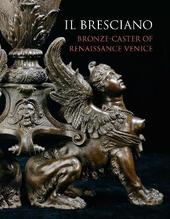
|
Il Bresciano: Bronze-caster of Renaissance Venice
Hardback
Main Details
| Title |
Il Bresciano: Bronze-caster of Renaissance Venice
|
| Authors and Contributors |
By (author) Charles Avery
|
| Physical Properties |
| Format:Hardback | | Pages:224 | | Dimensions(mm): Height 274,Width 212 |
|
| Category/Genre | Renaissance art
Sculpture
Individual artists and art monographs |
|---|
| ISBN/Barcode |
9781781301036
|
| Classifications | Dewey:730.92 |
|---|
| Audience | |
|---|
|
Publishing Details |
| Publisher |
Philip Wilson Publishers Ltd
|
| Imprint |
Philip Wilson Publishers Ltd
|
| Publication Date |
19 March 2020 |
| Publication Country |
United Kingdom
|
Description
'This monograph is a testament to the work of Charles Avery, who has put Il Bresciano on the map as a leading Italian Renaissance sculptor... Avery has established an impressively substantial oeuvre for Bresciano.' David Ekserdjian, The Art Newspaper 'Bien illustre, il fournit donc tout le materiel actuellement disponible pour connaitre un artiste qui meritait assurement d'etre tire de l'oubli ou dorment encore presque tous les bronziers de ce temps.' Bertrand Jestaz, le Bulletin Monumental, tome 178, 2020 A nucleus of sculptures cast by Andrea di Alessandri, commonly called from his native city, 'Il Bresciano', or from his products, 'Andrea dai bronzi', has been identified over the centuries. His style has been described as having similarities both with the High Renaissance of Sansovino and the Mannerism of Vittoria, the two successive master sculptors of sixteenth-century Venice, though he cast major bronzes for both. Andrea's signed masterpiece is a Paschal Candlestick in bronze, over two metres high and with sixty or more fascinating figures, made for Sansovino's magnificent lost church of Santo Spirito in 1568 and now in Santa Maria della Salute. The author's identification in 1996 of a pair of magnificent Firedogs with sphinx feet (which in 1568 had been recommended to Prince Francesco de'Medici in Florence), and in 2015 of an elaborate figurative bronze Ewer in Verona, have been the culmination of the process of recognition. Archival research has at last revealed the span of Andrea's life as 1524/25-1573, as well as many significant facts about his family and patronage. So the time is ripe for a comprehensive, well-illustrated, book on Il Bresciano, a 'new' and major bronzista in the great tradition of north Italy.
Author Biography
Charles Avery is a specialist on European sculpture, particularly Italian, French, English and Flemish. A graduate of Cambridge University and the Courtauld Institute of Art, he later obtained a doctorate from Cambridge. He is a Cavaliere of the Order of Merit of Italy, and has been a Fellow of the Society of Antiquaries of London and a Trustee of the British-Italian Society. He was Deputy Keeper of Sculpture at the Victoria & Albert Museum for twelve years, then a Director of Christie's for a decade: since 1990 he has been an independent historian, writer and lecturer. His published works include Giambologna: The Complete Sculpture; Renaissance and Baroque Bronzes in the Frick Art Museum; Donatello: An Introduction; David Le Marchand (1674-1726): 'An Ingenious Man for Carving in Ivory'; Bernini, Genius of the Baroque; The Triumph of Motion: Francesco Bertos (1678-1741); A School of Dolphins and Joseph de Levis & Company: Renaissance Bronze-founders in Verona (PWP).
ReviewsThis monograph is a testament to the work of Charles Avery, who has put Il Bresciano on the map as a leading Italian Renaissance sculptor... Avery has established an impressively substantial oeuvre for Bresciano. -- David Ekserdjian * The Art Newspaper * Bien illustre, il fournit donc tout le materiel actuellement disponible pour connaitre un artiste qui meritait assurement d'etre tire de l'oubli ou dorment encore presque tous les bronziers de ce temps. -- Bertrand Jestaz * le Bulletin Monumental * Charles Avery has been on the trail of Il Bresciano for decades and ... he makes the case for setting the sculptor alongside more well-known masters of bronze in 16th century Venice. * Apollo * This excellent monograph is a major contribution to our understanding of Venetian Renaissance sculpture, eloquently demonstrating that, in his best works, he was a gifted and fluent craftsman. -- Jeremy Warren * The Burlington Magazine *
|